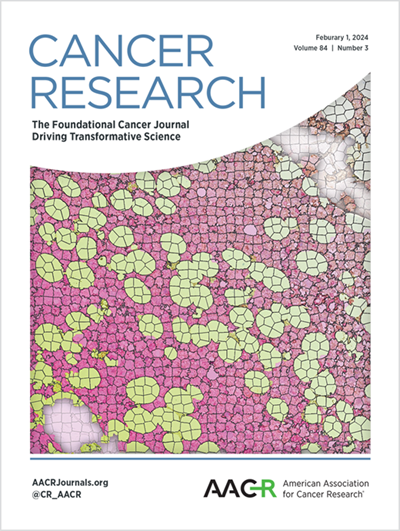The Genomic Landscape of Benign and Malignant Thyroid Tumors from Individuals Carrying Germline PTEN Variants Is Distinct from Sporadic Thyroid Cancers
IF 12.5
1区 医学
Q1 ONCOLOGY
引用次数: 0
Abstract
Patients with PTEN hamartoma tumor syndrome (PHTS), a molecular diagnosis for those carrying germline PTEN pathogenic variants, have a high prevalence of benign and malignant thyroid disease. Characterizing the genomic landscape in PHTS thyroid tumors could provide insights into malignant potential and tumor progression to help optimize diagnosis, surveillance, and treatment in this population. To reveal the somatic alterations in PHTS-associated thyroid tumors, we conducted exome sequencing on 58 thyroid tumors (28 cancers, 30 benign nodules) from 19 patients with PHTS. A control cohort of 447 sporadic papillary thyroid cancers (PTC) from The Cancer Genome Atlas was used for comparison. PHTS-associated thyroid tumors had a unique genomic landscape in the setting of a pathogenic germline PTEN mutation, when compared with the general population. PHTS-associated thyroid tumors demonstrated a high frequency of second-hit somatic PTEN alterations, including variants and loss-of-heterozygosity events. Second-hit somatic PTEN alterations were more prevalent in PHTS-associated PTC than sporadic PTC (65.2% vs. 0.067%), occurring frequently in PHTS-associated follicular thyroid cancer (100%) and benign follicular nodules (90%). PHTS-associated PTC additionally harbored somatic alterations in BRAF, RAS family members, and genes associated with DNA double-stranded break repair, as well as somatic arm-level copy-number variations. Together, these findings suggest that biallelic PTEN alterations may function as foundational mutations in PHTS thyroid tissue, promoting benign growth and increasing potential for malignant transformation through impaired DNA double-stranded break repair and increased genomic instability. The unique genomic landscape of PHTS-associated thyroid tumors carries implications for molecular-targeted therapies for patients. Significance: Exome sequencing reveals the distinct mutational landscape of PTEN hamartoma tumor syndrome–associated thyroid cancers from sporadic counterparts, providing insights into tumor progression and behavior that could help improve diagnosis, surveillance, and treatment.携带基因 PTEN 变异的良性和恶性甲状腺肿瘤的基因组图谱有别于散发性甲状腺癌
PTEN hamartoma肿瘤综合征(PHTS)是一种针对携带种系PTEN致病变异的患者的分子诊断方法,该综合征患者中良性和恶性甲状腺疾病的发病率都很高。描述PHTS甲状腺肿瘤的基因组特征有助于深入了解恶性可能性和肿瘤进展,从而帮助优化该人群的诊断、监测和治疗。为了揭示PHTS相关甲状腺肿瘤的体细胞改变,我们对19名PHTS患者的58个甲状腺肿瘤(28个癌症,30个良性结节)进行了外显子测序。癌症基因组图谱》(The Cancer Genome Atlas)中的447例散发性甲状腺乳头状癌(PTC)作为对照组进行比较。与普通人群相比,PHTS相关甲状腺肿瘤在致病性种系PTEN突变的情况下具有独特的基因组图谱。PHTS相关甲状腺肿瘤显示出高频率的二次体细胞PTEN改变,包括变异和杂合性缺失事件。与散发性PTC相比,二次体细胞PTEN改变在PHTS相关PTC中更为普遍(65.2%对0.067%),在PHTS相关滤泡性甲状腺癌(100%)和良性滤泡性结节(90%)中频繁出现。PHTS相关的PTC还存在BRAF、RAS家族成员和DNA双链断裂修复相关基因的体细胞改变,以及体细胞臂水平的拷贝数变异。这些发现共同表明,双拷贝PTEN改变可能是PHTS甲状腺组织中的基础突变,通过DNA双链断裂修复受损和基因组不稳定性增加,促进良性生长并增加恶性转化的可能性。PHTS相关甲状腺肿瘤独特的基因组结构对患者的分子靶向治疗具有重要意义。意义重大:外显子组测序揭示了PTEN hamartoma肿瘤综合征相关甲状腺癌与散发性甲状腺癌不同的突变情况,为了解肿瘤的进展和行为提供了线索,有助于改善诊断、监测和治疗。
本文章由计算机程序翻译,如有差异,请以英文原文为准。
求助全文
约1分钟内获得全文
求助全文
来源期刊

Cancer research
医学-肿瘤学
CiteScore
16.10
自引率
0.90%
发文量
7677
审稿时长
2.5 months
期刊介绍:
Cancer Research, published by the American Association for Cancer Research (AACR), is a journal that focuses on impactful original studies, reviews, and opinion pieces relevant to the broad cancer research community. Manuscripts that present conceptual or technological advances leading to insights into cancer biology are particularly sought after. The journal also places emphasis on convergence science, which involves bridging multiple distinct areas of cancer research.
With primary subsections including Cancer Biology, Cancer Immunology, Cancer Metabolism and Molecular Mechanisms, Translational Cancer Biology, Cancer Landscapes, and Convergence Science, Cancer Research has a comprehensive scope. It is published twice a month and has one volume per year, with a print ISSN of 0008-5472 and an online ISSN of 1538-7445.
Cancer Research is abstracted and/or indexed in various databases and platforms, including BIOSIS Previews (R) Database, MEDLINE, Current Contents/Life Sciences, Current Contents/Clinical Medicine, Science Citation Index, Scopus, and Web of Science.
 求助内容:
求助内容: 应助结果提醒方式:
应助结果提醒方式:


